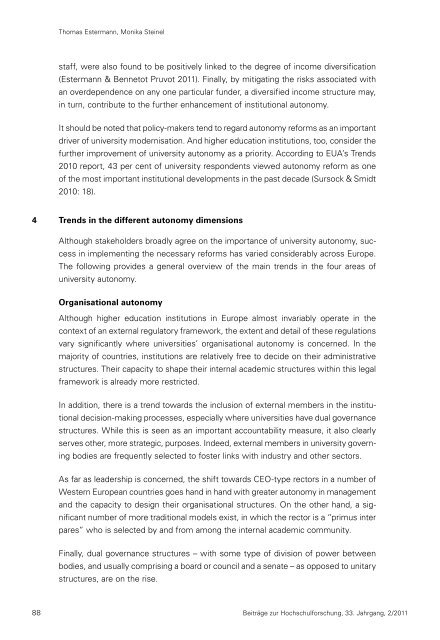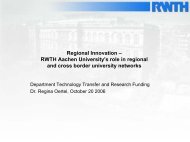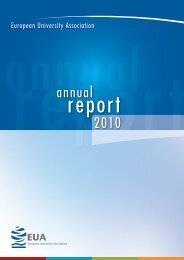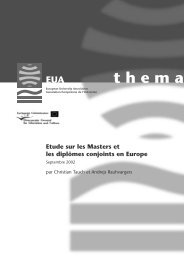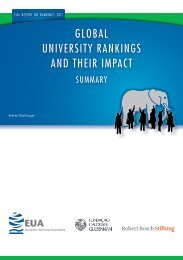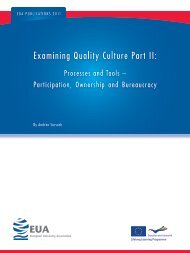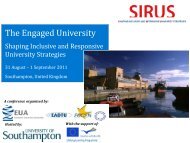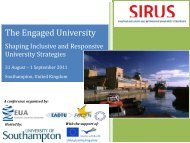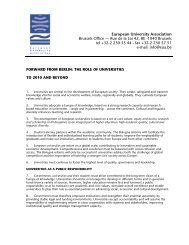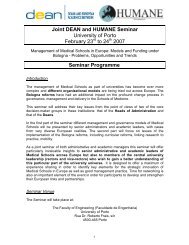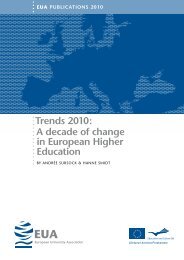Beiträge zur Hochschulforschung - European University Association
Beiträge zur Hochschulforschung - European University Association
Beiträge zur Hochschulforschung - European University Association
You also want an ePaper? Increase the reach of your titles
YUMPU automatically turns print PDFs into web optimized ePapers that Google loves.
88<br />
Thomas Estermann, Monika Steinel<br />
staff, were also found to be positively linked to the degree of income diversification<br />
(Estermann & Bennetot Pruvot 2011). Finally, by mitigating the risks associated with<br />
an overdependence on any one particular funder, a diversified income structure may,<br />
in turn, contribute to the further enhancement of institutional autonomy.<br />
It should be noted that policy-makers tend to regard autonomy reforms as an important<br />
driver of university modernisation. And higher education institutions, too, consider the<br />
further improvement of university autonomy as a priority. According to EUA’s Trends<br />
2010 report, 43 per cent of university respondents viewed autonomy reform as one<br />
of the most important institutional developments in the past decade (Sursock & Smidt<br />
2010: 18).<br />
4 Trends in the different autonomy dimensions<br />
Although stakeholders broadly agree on the importance of university autonomy, suc-<br />
cess in implementing the necessary reforms has varied considerably across Europe.<br />
The following provides a general overview of the main trends in the four areas of<br />
university autonomy.<br />
Organisational autonomy<br />
Although higher education institutions in Europe almost invariably operate in the<br />
context of an external regulatory framework, the extent and detail of these regulations<br />
vary significantly where universities’ organisational autonomy is concerned. In the<br />
majority of countries, institutions are relatively free to decide on their administrative<br />
structures. Their capacity to shape their internal academic structures within this legal<br />
framework is already more restricted.<br />
In addition, there is a trend towards the inclusion of external members in the institu-<br />
tional decision-making processes, especially where universities have dual governance<br />
structures. While this is seen as an important accountability measure, it also clearly<br />
serves other, more strategic, purposes. Indeed, external members in university govern-<br />
ing bodies are frequently selected to foster links with industry and other sectors.<br />
As far as leadership is concerned, the shift towards CEO-type rectors in a number of<br />
Western <strong>European</strong> countries goes hand in hand with greater autonomy in management<br />
and the capacity to design their organisational structures. On the other hand, a sig-<br />
nificant number of more traditional models exist, in which the rector is a “primus inter<br />
pares” who is selected by and from among the internal academic community.<br />
Finally, dual governance structures – with some type of division of power between<br />
bodies, and usually comprising a board or council and a senate – as opposed to unitary<br />
structures, are on the rise.<br />
<strong>Beiträge</strong> <strong>zur</strong> <strong>Hochschulforschung</strong>, 33. Jahrgang, 2/2011


